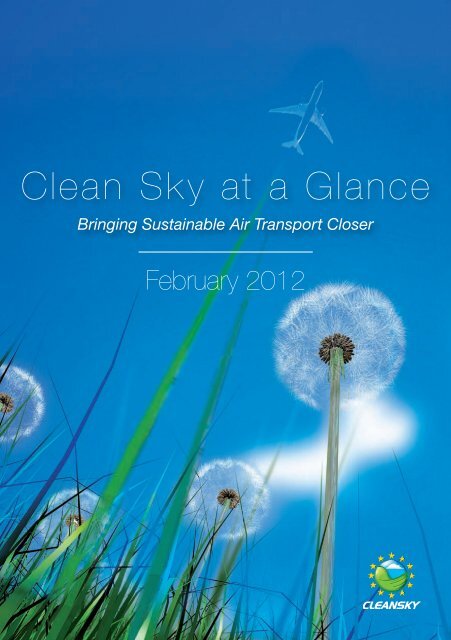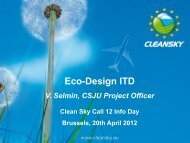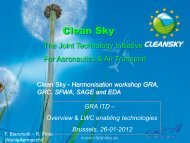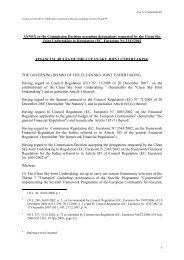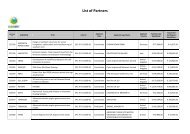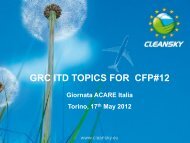Bringing Sustainable Air Transport Closer - Clean Sky
Bringing Sustainable Air Transport Closer - Clean Sky
Bringing Sustainable Air Transport Closer - Clean Sky
You also want an ePaper? Increase the reach of your titles
YUMPU automatically turns print PDFs into web optimized ePapers that Google loves.
<strong>Clean</strong> <strong>Sky</strong> at a Glance<br />
<strong>Bringing</strong> <strong>Sustainable</strong> <strong>Air</strong> <strong>Transport</strong> <strong>Closer</strong><br />
February 2012
1<br />
Introduction<br />
<strong>Clean</strong> <strong>Sky</strong> is a Joint Technology Initiative (JTI) that aims to develop and mature breakthrough<br />
‘clean technologies’ for <strong>Air</strong> <strong>Transport</strong>. By accelerating their deployment, the JTI<br />
will contribute to Europe’s strategic environmental and social priorities, and simultaneously<br />
promote competitiveness and sustainable economic growth.<br />
Joint Technology Initiatives are specific large scale research projects created by the European<br />
Commission within the 7 th Framework Programme (FP7) in order to allow the achievement<br />
of ambitious and complex research goals. Set up as a Public Private Partnership between<br />
the European Commission and the European aeronautical industry, <strong>Clean</strong> <strong>Sky</strong> will pull<br />
together the formidable research and technology resources of the European Union in a<br />
coherent, 7-year, €1.6 bn programme. It will contribute significantly to the ’greening’ of<br />
aviation: an essential part of today’s global society, bringing people and cultures together<br />
and creating economic growth.<br />
The <strong>Clean</strong> <strong>Sky</strong> goal is to identify, develop and validate the key technologies necessary to<br />
achieve major steps towards the ACARE 1 environmental goals for 2020 when compared<br />
to 2000 levels:<br />
• Fuel consumption and carbon dioxide (CO ) emissions reduced by 50%<br />
2<br />
• Nitrous oxides (NO ) emissions reduced by 80%<br />
X<br />
• Perceived external noise reduction of 50%<br />
• Improved environmental impact of the lifecycle of aircraft and related products.<br />
1 Advisory Council for Aeronautics Research in Europe<br />
Fuel burn reduction<br />
Recycling<br />
<strong>Bringing</strong> <strong>Sustainable</strong> <strong>Air</strong> <strong>Transport</strong> <strong>Closer</strong><br />
Geared fan<br />
Open rotor<br />
innovative rotor blades<br />
CO 2 reduction<br />
Low drag<br />
More electric<br />
NOx reduction<br />
Laminar wing<br />
Diesel Engine<br />
Energy management<br />
Life cycle assessment<br />
Noise reduction<br />
Optimised flightpath<br />
Light weight structures
Technologies, Concept <strong>Air</strong>craft and Demonstration Programmes form the three complementary<br />
instruments used by <strong>Clean</strong> <strong>Sky</strong> in meeting these goals:<br />
Technologies are selected, developed and monitored in terms maturity, or ‘technology readiness<br />
level’ (TRL). A detailed list of more than one hundred key technologies has been set. The<br />
technologies developed by <strong>Clean</strong> <strong>Sky</strong> will cover all major segments of commercial aircraft.<br />
Concept <strong>Air</strong>craft are design studies dedicated to integrating technologies into a viable conceptual<br />
configuration. They cover a broad range of aircraft: business jets, regional and large<br />
commercial aircraft, as well as rotorcraft. They are categorised in order to represent the major<br />
future aircraft families. <strong>Clean</strong> <strong>Sky</strong>’s environmental results will be measured and reported principally<br />
by comparing these Concept <strong>Air</strong>craft to existing aircraft, and aircraft incorporating ‘evolutionary<br />
technology’ in the world fl eet.<br />
Demonstration Programmes include physical demonstrators that integrate several technologies<br />
at a larger ‘system’ or aircraft level, and validate their feasibility in operating conditions.<br />
This helps determine the true potential of the technologies and enables a realistic environmental<br />
assessment. Demonstrations enable technologies to reach a higher level of maturity (TRL). The<br />
ultimate goal of <strong>Clean</strong> <strong>Sky</strong> is to achieve TRLs corresponding to successful demonstration in a<br />
relevant operating environment. This is the highest TRL achievable in research.<br />
O<br />
<strong>Clean</strong> <strong>Sky</strong> at a glance<br />
www.cleansky.eu<br />
2
3<br />
Concept aircraft & environmental objectives<br />
Concept <strong>Air</strong>craft will enable assessment of the environmental benefi ts of <strong>Clean</strong> <strong>Sky</strong> technologies<br />
across nearly the full spectrum of commercial aviation. Some key confi gurations that will be<br />
developed follow below.<br />
Business Jet Concept <strong>Air</strong>craft<br />
- Low Speed Business Jet:<br />
This concept aircraft includes a low-drag laminar<br />
fl ow wing with low speed, and will feature a radically<br />
redesigned rear empennage. This innovative<br />
empennage aims to drastically reduce the community<br />
noise by shielding noise from the future<br />
generation turbofan engine with elements of the<br />
horizontal and vertical tail plane.<br />
- High Speed Business Jet:<br />
This concept aircraft includes a ‘smart’ low-drag, highly swept wing design, making use of passive<br />
and active laminar fl ow. The wing’s high speed design aims to include a “smart fl ap” concept. New<br />
environmentally friendly materials and processes as well as new fl ight trajectories will be included.<br />
Regional Concept <strong>Air</strong>craft<br />
<strong>Bringing</strong> <strong>Sustainable</strong> <strong>Air</strong> <strong>Transport</strong> <strong>Closer</strong><br />
- Regional Turboprop:<br />
The 90-passenger Regional Turboprop <strong>Air</strong>craft represents<br />
a concept for a next generation ‘turboprop’<br />
that could enter into service in 2020-2025. It features<br />
advanced technologies in almost all sub-systems: low<br />
weight structure, extensive use of electrical power<br />
in systems (bleed-less engine), and advanced fl ight<br />
management systems. A substantial reduction of the<br />
environmental impact will be achievable.<br />
- Regional Jet<br />
The 130-passenger Regional Jet <strong>Air</strong>craft is a concept<br />
aircraft that could likewise have an entry into<br />
service around 2020-2025. By utilising a next<br />
generation power-plant (Open Rotor or Advanced<br />
Geared Turbofan), and similar advanced technologies<br />
in sub-systems, it too will deliver superior<br />
environmental performance.
Large Commercial Concept <strong>Air</strong>craft<br />
- Short / Medium Range <strong>Air</strong>craft, Open Rotor:<br />
This concept aircraft includes the all new ‘smart’<br />
laminar-fl ow wing and key enabling technologies to<br />
design, manufacture and operate this. The concept<br />
aircraft will incorporate the <strong>Clean</strong> <strong>Sky</strong> Contra Rotating<br />
Open Rotor (CROR) engine concepts; subsequent<br />
fl ight-testing of a full size CROR engine demonstrator<br />
in the demonstration programme will aid in determining<br />
the full potential and maturity of the propulsion architecture.<br />
Advanced systems and new fl ight trajectories<br />
are planned to be included into the architecture.<br />
- Long Range <strong>Air</strong>craft, Next Generation Large Turbofan:<br />
The long range aircraft concept will provide the vehicle level platform to integrate the next<br />
generation large three shaft turbofan engine using <strong>Clean</strong> <strong>Sky</strong> technologies. It should be noted<br />
that major new long range aircraft will have entered the world fl eet by 2015 2 , and therefore no<br />
new aircraft introductions are likely in the 2020 timeframe. Thus, the focus of <strong>Clean</strong> <strong>Sky</strong> in this<br />
aircraft category is predominantly on improved engines and systems.<br />
2 E.g. <strong>Air</strong>bus A350 Family<br />
<strong>Clean</strong> <strong>Sky</strong> at a glance<br />
www.cleansky.eu<br />
4
Rotorcraft: Concept <strong>Air</strong>craft<br />
- Light Single-engine Helicopter:<br />
The light single engine helicopter concept is equipped<br />
with future generation single turboshaft or with a Diesel<br />
piston engine, with optimised engine installations<br />
respectively. Superior performance is further enhanced<br />
by incorporating the latest innovative active blade technologies<br />
and applying radical redesign to empennage,<br />
skids and hub.<br />
- Light/Medium/Heavy Multi-engine helicopter:<br />
Generic light, medium and heavy concept helicopters are equipped with two or three future<br />
generation turboshaft with optimised engine installations. Their performance is further<br />
enhanced by incorporating the latest innovative active blade technologies, radical structural<br />
redesign, and the introduction of advanced electrical systems (including electric tail rotor) for<br />
the elimination of noxious hydraulic fl uid and reduced fuel consumption.<br />
3 ERICA: Enhanced Rotorcraft Innovative Concept Achievement – FP5/6<br />
5<br />
<strong>Bringing</strong> <strong>Sustainable</strong> <strong>Air</strong> <strong>Transport</strong> <strong>Closer</strong><br />
- Tilt-Rotor:<br />
The conceptual tilt-rotor aircraft is based on the<br />
European ERICA 3 tilt-rotor concept, characterised by<br />
a small rotor diameter and tiltable wing. Performance<br />
is enhanced by aerodynamic optimisation and the<br />
installation of a future generation turbo-shaft engine.
The environmental objectives of the programme are determined by evaluating the performance<br />
of concept aircraft in the global air transport system (when compared to 2000 level<br />
technology and to a “business as usual” evolution of technology). The ranges of potential<br />
improvements result from the groupings of technologies which are expected to reach the<br />
maturity of a successful demonstration within the programme timeframe. Not all of these<br />
technologies will be developed directly through the <strong>Clean</strong> <strong>Sky</strong> programme. But it is neither<br />
feasible nor relevant at this stage to isolate the benefits derived purely from <strong>Clean</strong> <strong>Sky</strong>.<br />
A signifi cant synergy effect in European Aeronautics Research is made possible, through<br />
<strong>Clean</strong> <strong>Sky</strong>, by maturing closely linked technologies to a materially higher TRL via demonstration<br />
and integration.<br />
CO 2 Reduction Potential (2020 Technologies, %)<br />
Baseline: 2000 Emissions<br />
-20<br />
-40<br />
-60<br />
Fixed Wing<br />
<strong>Air</strong>craft<br />
Rotorcraft: potential impact of Diesel Engine<br />
Rotorcraft<br />
<strong>Clean</strong> <strong>Sky</strong> at a glance<br />
The environmental performance<br />
gains we expect to see confi rmed<br />
through demonstration of the<br />
technologies are depicted in these<br />
graphs. They are representative<br />
fi gures across the different aircraft<br />
types and sectors (business jets,<br />
regional aircraft, large commercial<br />
aircraft and rotorcraft). There is broad<br />
similarity between the improvements<br />
foreseen across these different<br />
aircraft types despite the different<br />
modes of operation and the different<br />
technologies involved.<br />
Nonetheless, some specifi c opportunities<br />
and challenges should be<br />
mentioned.<br />
In the business jet sector, the potential use of a novel, radical re-design of the empennage<br />
(tail surfaces) could aid in shielding noise from the engines and further reduce community<br />
noise. As these aircraft often operate into very noise-sensitive local airports this design<br />
option will be elaborated further, potentially augmenting the gains that are feasible.<br />
www.cleansky.eu<br />
6
7<br />
NO X Reduction Potential (2020 Technologies, %)<br />
Baseline: 2000 Emissions<br />
-20<br />
-40<br />
-60<br />
-70<br />
<strong>Bringing</strong> <strong>Sustainable</strong> <strong>Air</strong> <strong>Transport</strong> <strong>Closer</strong><br />
Fixed Wing<br />
<strong>Air</strong>craft (2)<br />
(1) Rotorcraft: Turbofan based. Diesel NO X reduction more limited<br />
(2) Additional gains being investigated (new <strong>Clean</strong> <strong>Sky</strong> project areas)<br />
EPNdB<br />
-5<br />
-10<br />
-15<br />
(2)<br />
Rotorcraft (1)<br />
Noise Reduction Potential (2020 Technologies, EPNdB)<br />
Baseline: 2000 Emissions<br />
-50% Perceived Noise<br />
e Fixed Wing<br />
<strong>Air</strong>craft<br />
Rotorcraft<br />
Significant increase in benefits through<br />
flightpath optimisation<br />
In large commercial and regional jet<br />
aircraft, a key design option concerns<br />
the incorporation of the Counter<br />
Rotating Open Rotor (CROR) engine<br />
architecture and technology. This<br />
design option involves an important<br />
trade-off: signifi cantly more fuel burn<br />
and CO 2 reductions are expected,<br />
coupled with less progress on noise,<br />
when compared to future turbofan<br />
architectures. The fi gures in these<br />
graphs assume the use of CROR on<br />
short/medium haul aircraft. Fixed wing<br />
aircraft fi gures represent the median<br />
performance improvement across the<br />
spectrum of business jets, regional<br />
aircraft and short/medium range<br />
commercial aircraft. Long-range<br />
commercial aircraft are, as yet, not<br />
included as no (integrated) concept<br />
aircraft predictions are available.<br />
In rotorcraft, an innovation being<br />
investigated concerns the adoption<br />
of Diesel engine propulsion (on<br />
so-called light single-engine helicopters).<br />
The Diesel engine could<br />
deliver impressive fuel burn and CO 2<br />
benefi ts, albeit with a penalty in NO X<br />
performance when compared to a<br />
future turboshaft engine. The graphs<br />
depict the range of variance this<br />
would imply for both CO 2 and NO X .<br />
Note: noise reduction is measured in Effective Perceived Noise (EPNdB), and fi gures represent the average reduction per operation (take-off,<br />
approach or fl y-past). A reduction of 10 EPNdB is widely accepted as corresponding to a halving of perceived noise in terms of the human<br />
auditive capacity and perception. The ACARE target of ‘halving perceived noise’ thus corresponds with a fi gure in the graph of -10 EPNdB.
Demonstration programme<br />
While some technologies can be assessed during their development phase, many key technologies<br />
will need to be validated via dedicated test programmes, involving in-fl ight or large-scale<br />
ground demonstration installations. These demonstrators combine several technologies at a<br />
major system or at aircraft level, enabling them to be tested in a relevant operating environment.<br />
Their performance is evaluated in areas such as mechanical or in-fl ight behaviour. This will<br />
help to determine the true potential of the technologies and to enable a realistic environmental<br />
assessment. Demonstrations enable technologies to reach a higher level of maturity (TRL), which<br />
is the “raison d’être” of <strong>Clean</strong> <strong>Sky</strong> as a ‘Level 3’ highly integrated project and Joint Technology<br />
Initiative within the European Framework Research and Innovation Programme.<br />
Contra Rotating Open Rotor (CROR) Demo Engine Flying Test Bed<br />
High Speed Demonstrator for passive laminar-flow wing technologies<br />
✓ Advanced passive laminar wing aerodynamic design<br />
✓ Two alternative integrated structural concepts for a laminar wing<br />
✓ High quality, low tolerance manufacturing and repair techniques<br />
✓ Anti contamination surface coating<br />
✓ Shielding Krüger high lift device<br />
Q4/2014<br />
✓ New propeller design (high performance, low noise)<br />
✓ Engine - Pylon – <strong>Air</strong>craft integration concept<br />
✓ New CROR – Engine integration technology<br />
✓ Advanced CROR aero-acoustic design<br />
Q3/2016<br />
Low Speed Demonstrator for advanced control surfaces for high lift<br />
✓ Smart fl ap concept, with combined function for<br />
manoeuvre control and high lift<br />
✓ Active fl ow control at the leading edge to replace slats<br />
✓ Active fl ow control fl aps for increased high lift performance<br />
Q4/2014<br />
<strong>Clean</strong> <strong>Sky</strong> at a glance<br />
www.cleansky.eu<br />
8
9<br />
Regional <strong>Air</strong>craft Integrated Flight Test Demonstration<br />
✓ Advanced metallic & composite structure<br />
✓ Structural health monitoring<br />
✓ Electrical environmental control system<br />
✓ Hybrid wing ice protection system<br />
✓ Application and scaling of more-electric technologies and<br />
power management for regional aircraft<br />
Q3/2015<br />
Regional <strong>Air</strong>craft Static & Fatigue Full Scale Ground Demonstration<br />
Regional <strong>Air</strong>craft Large Scale Wind Tunnel Test Rotorcraft lift & drag demonstrators<br />
✓ Turbulent fl ow skin friction reduction<br />
✓ Natural laminar fl ow wing<br />
✓ Load control / alleviation<br />
✓ Low noise landing gears<br />
✓ Low noise high lift devices<br />
Q2/2015<br />
<strong>Bringing</strong> <strong>Sustainable</strong> <strong>Air</strong> <strong>Transport</strong> <strong>Closer</strong><br />
✓ Advanced Al-Li structures and processes<br />
✓ Multi-functional composite materials<br />
Q2/2015
Rotorcraft lift & drag demonstrators<br />
Diesel engine demonstrator for light helicopters<br />
✓ Core Diesel engine design<br />
✓ Power-pack integration<br />
Q2/2014<br />
<strong>Air</strong>craft & Rotorcraft Systems Demonstrators<br />
✓ Innovative rotor blades:<br />
- Active twist blade and Gurney fl ap rotor<br />
- 3-D blade profi le optimised for dual speed rotor<br />
✓ Shape optimisation and fl ow separation control<br />
devices enabling drag reduction<br />
Q2/2015<br />
✓ Technologies for fl ight path optimisation<br />
Q1/2015<br />
✓ Technologies for «All-Electric» architectures<br />
✓ Environmental control systems<br />
✓ Electrical actuation<br />
✓ Nacelle-based systems<br />
✓ Anti-ice<br />
✓ Electrical wheel drive/taxiing<br />
✓ Rotorcraft: electrical main rotor actuators<br />
✓ Rotorcraft: electrical tail rotor<br />
Q3/2015<br />
<strong>Clean</strong> <strong>Sky</strong> at a glance<br />
www.cleansky.eu<br />
10
11<br />
Geared Open Rotor Demonstrator<br />
Large Three-shaft Engine Demonstrator<br />
✓ Lightweight fan system<br />
✓ Advanced external engine components and accessories<br />
✓ Advanced ‘intercase’ structures<br />
✓ Lightweight and effi cient low-pressure turbine<br />
Q2/2013<br />
Advanced Geared Turbofan Demonstrator<br />
Advanced Turboshaft Demonstrator<br />
✓ High effi ciency compressor, combustion chamber,<br />
high-pressure and low-pressure turbine<br />
✓ Full scale & life cycle validation<br />
Q1/2013<br />
<strong>Bringing</strong> <strong>Sustainable</strong> <strong>Air</strong> <strong>Transport</strong> <strong>Closer</strong><br />
✓ Propeller/Propulsor<br />
✓ Pitch change mechanism<br />
✓ Gear-box<br />
✓ Rotating structure<br />
Q4/2015<br />
✓ Advanced Geared Turbofan Demonstrator<br />
✓ New highly effi cient high-pressure compressor<br />
✓ Light weight, high speed low-pressure turbine<br />
✓ Advanced light weight and effi cient turbine structures<br />
✓ Light weight and reliable fan drive gear system<br />
✓ New systems for a more electric engine<br />
Q4/2013
<strong>Clean</strong> <strong>Sky</strong> programme structure<br />
<strong>Clean</strong> <strong>Sky</strong> activities are performed within six “Integrated Technology Demonstrators” (ITDs) and<br />
a “Technology Evaluator”. The organisation is shown in the following figure.<br />
<strong>Sustainable</strong><br />
and Green<br />
Engines<br />
Systems for<br />
Green<br />
Operations<br />
Eco-Design<br />
Technology Evaluator<br />
Concept <strong>Air</strong>craft<br />
Eco-Design Smart Fixed Wing Green Regional Green Rotorcraft<br />
<strong>Air</strong>craft<br />
The three vehicle-based ITDs will develop, deliver and integrate technologies into concrete aircraft<br />
confi gurations. The three ‘transversal’ ITDs are focused on propulsion, systems and design<br />
methodologies. They will deliver technologies, which will be integrated alongside aircraft-level<br />
and ‘airframe’ based technologies in the various aircraft confi gurations by the vehicle ITDs.<br />
Smart Fixed Wing <strong>Air</strong>craft (SFWA) – co-led by <strong>Air</strong>bus and SAAB - will deliver innovative wing<br />
technologies together with new aircraft confi gurations, covering large aircraft and business jets.<br />
Key enabling technologies from the transversal ITDs, for instance Contra Rotating Open Rotor,<br />
will be integrated into the demonstration programmes and concept aircraft.<br />
Green Regional <strong>Air</strong>craft (GRA) – co-led by Alenia and EADS CASA - will develop new technologies<br />
for the reduction of noise and emissions, in particular advanced low-weight & high performance<br />
structures, incorporation of all-electric systems, bleed-less engine architecture, low noise / high<br />
effi ciency aerodynamics, and environmentally optimised mission and trajectory management.<br />
<strong>Clean</strong> <strong>Sky</strong> at a glance<br />
<strong>Air</strong>craft<br />
TECHNOLOGIES &<br />
DEMONSTRATORS<br />
www.cleansky.eu<br />
12
13<br />
Green Rotorcraft (GRC) – co-led by AgustaWestland and Eurocopter - will deliver innovative<br />
rotor blade technologies for reduction in rotor noise and power consumption, technologies<br />
for lower airframe drag, environmentally friendly fl ight paths, the integration of Diesel engine<br />
technology, and advanced electrical systems for elimination of hydraulic fl uid and for improved<br />
fuel consumption.<br />
<strong>Sustainable</strong> and Green Engines (SAGE) – co-led by Rolls-Royce and Safran - will design and<br />
build fi ve engine demonstrators to integrate technologies for low fuel consumption, whilst<br />
reducing noise levels and nitrous oxides. The ‘Open Rotor’ is the target of two demonstrators.<br />
The others address geared turbofan technology, low pressure stages of a three-shaft engine<br />
and a new turboshaft engine for helicopters.<br />
Systems for Green Operations (SGO) – co-led by Liebherr and Thales - will focus on allelectrical<br />
aircraft equipment and system architectures, thermal management, capabilities for<br />
environmentally-friendly trajectories and missions, and improved ground operations to give any<br />
aircraft the capability to fully exploit the benefits of the ‘Single European <strong>Sky</strong>’.<br />
Eco-Design (ECO) – co-led by Dassault Aviation and Fraunhofer Gesellschaft – will support<br />
the ITDs with environmental impact analysis of the product life-cycle. Eco-Design will focus on<br />
green design and production, maintenance, withdrawal, and recycling of aircraft. The optimal<br />
use of raw materials and energies, avoidance of hazardous materials, and the reduction of<br />
non-renewable energy consumptions of systems on-board will help to considerably reduce<br />
the environmental impact of the aircraft and its systems.<br />
Complementing these six ITDs, the Technology Evaluator (TE) is a dedicated evaluation<br />
platform cross-positioned within the <strong>Clean</strong> <strong>Sky</strong> programme structure. The TE is co-led by<br />
DLR and Thales, and includes the major European aeronautical research organisations. It will<br />
assess the environmental impact of the technologies developed by the ITDs and integrated<br />
into the concept aircraft. By doing this, the TE will enable <strong>Clean</strong> <strong>Sky</strong> to measure and report<br />
the level of success in achieving the environmental objectives, and in contributing towards<br />
the ACARE environmental goals. Besides a mission level analysis (aircraft level), the positive<br />
impact of the <strong>Clean</strong> <strong>Sky</strong> technologies, will be shown within an airport environment and across<br />
the global air transport system.<br />
<strong>Bringing</strong> <strong>Sustainable</strong> <strong>Air</strong> <strong>Transport</strong> <strong>Closer</strong>
Way forward<br />
The fi rst assessment by the Technology Evaluator on the way to meeting our environmental<br />
objectives has been completed in early 2012 and results broadly confi rm the objectives set<br />
for the programme.<br />
The ranges of potential performance improvement (reduction in CO 2 , NO X and Noise) will be<br />
narrowed or evolved during the life of the programme based on the results from the key technologies<br />
developed and validated through the demonstrations performed.<br />
<strong>Clean</strong> <strong>Sky</strong> is a ‘living’ programme: each year, Annual Implementation Plans are produced and<br />
agreed, and research priorities are (re-)calibrated based on results achieved. The best approach<br />
to progressing the technologies is pursued. The <strong>Clean</strong> <strong>Sky</strong> JU uses regular Calls for Proposals<br />
to engage with the wider aeronautical industry, research organisations and universities in order<br />
to bring the best talent on-board and enable broad collaborative participation. A very signifi cant<br />
share of the <strong>Clean</strong> <strong>Sky</strong> research programme is already being taken on by Europe’s aerospace<br />
related SMEs, and in January 2012 the 11 th Call for Proposal was launched. In June 2011, a major<br />
and exciting milestone was reached with the 400 th partner joining the <strong>Clean</strong> <strong>Sky</strong> programme.<br />
For organisations interested in further information on <strong>Clean</strong> <strong>Sky</strong>, or becoming involved in the<br />
Programme, regular updates are published on www.cleansky.eu<br />
There, further information is available on the programme’s research topics, and the selection<br />
criteria and process for participating, such as the Calls for Proposals.<br />
<strong>Clean</strong> <strong>Sky</strong> at a glance<br />
www.cleansky.eu<br />
14
Copyright @ 2012<br />
<strong>Clean</strong> <strong>Sky</strong> JU<br />
Brussels, Belgium<br />
White Atrium Building<br />
Avenue de la Toison d’Or 56-60<br />
1060 Brussels<br />
Phone: +32 2 221 81 52


